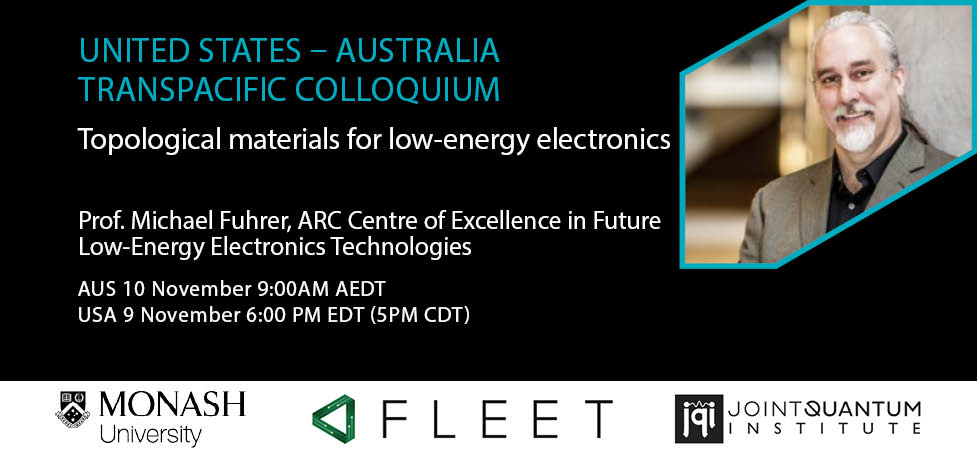-
10 Nov 2021
9:00 am - 10:00 am
Prof. Michael Fuhrer, School of Physics and Astronomy, and ARC Centre of Excellence in Future Low-Energy Electronics Technologies, Monash University.
Missed the seminar. Catch up on YouTube
The impending end of Moore’s Law has prompted a search for a new computing technology with vastly lower energy consumed per operation than silicon CMOS. The recent discovery of topological phases of matter offers a possible solution: a “topological transistor” in which an electric field tunes a material from a conventional insulator “off” state to a topological insulator “on” state, in which topologically protected edge modes carry dissipationless current. Due to the combined effects of Rashba spin-orbit interaction and electric field control of the bandgap, the topological transistor may switch at lower voltage, overcoming “Boltzmann’s tyranny”.
I will discuss our work on atomically thin films of Na3Bi (a topological Dirac semimetal) as a platform for a topological transistor. We study thin films of Na3Bi grown in ultra-high vacuum by molecular beam epitaxy, characterized with electronic transport, scanning tunneling microscopy (STM), and angle-resolved photoemission spectroscopy. When thinned to a few atomic layers Na3Bi is a large gap (>300 meV) 2D topological insulator with topologically protected edge modes observable in STM. Electric field applied perpendicular to the Na3Bi film, by potassium doping or by proximity of an STM tip, closes the bandgap completely and reopens it as a conventional insulator. Electrical transport measurements demonstrate that the current is carried by helical topological edge modes over millimeter-scale distances. The large bandgap of 2D Na3Bi, significantly greater than room temperature, and its compatibility with silicon, make it a promising platform for topological transistors.
Prof. Fuhrer received his B.S. in Physics from the University of Texas at Austin in 1990, and Ph. D. in Physics from the University of California at Berkeley in 1998. After a postdoctoral appointment at Lawrence Berkeley National Laboratory, Fuhrer joined the faculty at the University of Maryland as an Assistant Professor in 2000, and from 2009-2012 was Professor, and Director of the Center for Nanophysics and Advanced Materials. In 2012 Fuhrer was awarded an ARC Laureate Fellowship, and moved to Monash University as Professor of Physics in 2013. Fuhrer founded the Monash Centre for Atomically Thin Materials, and directs the ARC Centre of Excellence in Future Low-Energy Electronics Technologies. Fuhrer’s current research interests lie in understanding the electronic properties of atomically-thin materials (such as graphene and transition-metal chalcogenides), and topological materials. Fuhrer is a Fellow of the American Physical Society and the American Association for the Advancement of Science.
This talk is part of an ongoing series of talks by US and Australian researchers presenting novel developments in condensed matter and cold atomic physics, enriching connections between the two physics communities. Co-presented by FLEET, Monash School of Physics and Astronomy, and the Joint Quantum Institute.
References
Nadeem, I. Di Bernardo, X. Wang, M.S. Fuhrer, and D. Culcer, Nano Letters 21, 3155–3161 (2021).
Hellerstedt, M. T. Edmonds, N. Ramakrishnan, C. Liu, B. Weber, A. Tadich, K. M. O’Donnell, S. Adam and M.S. Fuhrer, Nano Letters 16 (5), 3210-3214 (2016).
M.T. Edmonds, J.L. Collins, J. Hellerstedt, I. Yudhistira, L.C. Gomes, J.N.B. Rodrigues, S. Adam, M.S. Fuhrer, Science Advances 3, eaao6661 (2017).
J.L. Collins, A. Tadich, W. Wu, L.C. Gomes, J.N.B. Rodrigues, C. Liu, J. Hellerstedt, H. Ryu, S. Tang, S.-K. Mo, S. Adam, S.A. Yang, M.S. Fuhrer & M.T. Edmonds, Nature 564, 390-394 (2018).
C. Liu, D. Culcer, Z. Wang, M.T. Edmonds, and M.S. Fuhrer, Nano Letters 9, 6306 (2020).

